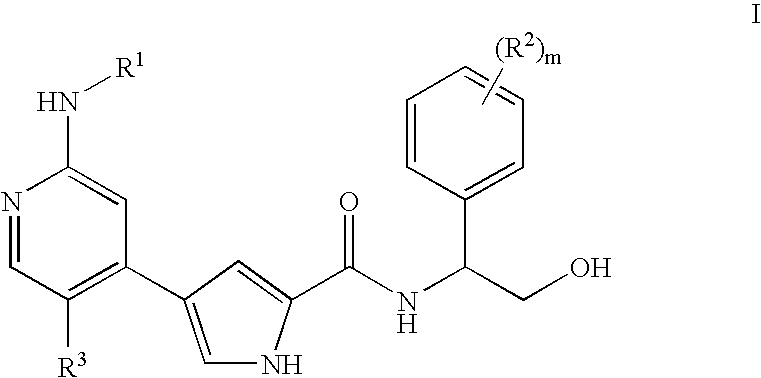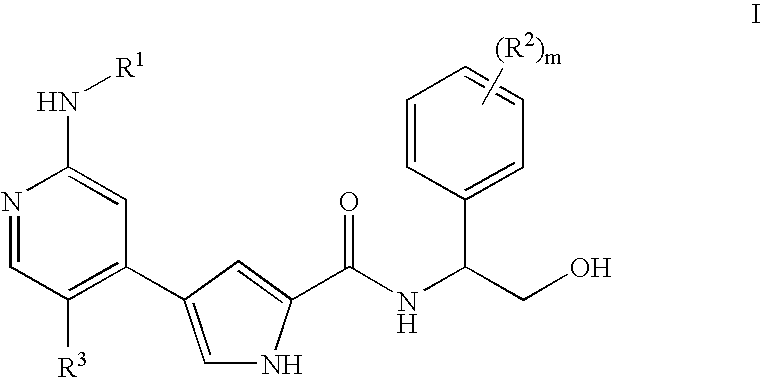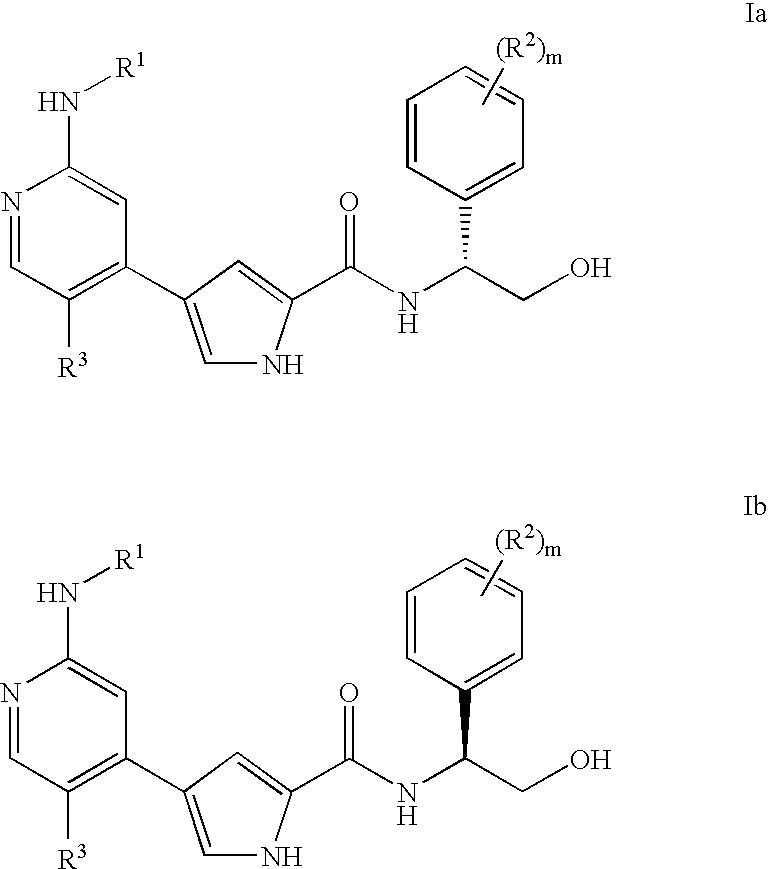Pyrrole inhibitors of ERK protein kinase, synthesis thereof and intermediates thereto
a technology of erk protein kinase and pyrrole, which is applied in the direction of biocide, drug composition, immunological disorders, etc., can solve the problems of poor clinical prognosis and achieve the effect of treating or lessening the severity
- Summary
- Abstract
- Description
- Claims
- Application Information
AI Technical Summary
Benefits of technology
Problems solved by technology
Method used
Image
Examples
example 1
[0193]Compound I-9 was prepared as follows:
[0194]
[0195]2,2,2-Trichloro-1-(4-iodo-1H-pyrrol-2-yl)ethanone: To a stirred solution of 50 g (235 mmol, 1.0 equiv.) of 2,2,2-trichloro-1-(1H-pyrrol-2-yl)-ethanone in dry dichloromethane (400 mL) under nitrogen, a solution of iodine monochloride (39 g, 240 mmol, 1.02 equivalents) in of dichloromethane (200 mL) was added dropwise. The resulting mixture was stirred at room temperature for 2 hours. The solution was washed with 10% potassium carbonate, water, 1.0 M sodium thiosulfate, saturated sodium chloride, dried over sodium sulfate, filtered, and concentrated under reduced pressure. The solid was recrystallized from hexanes / methyl acetate to afford the title compound (68.5 g, 86%) as a colorless solid (86%). MS FIA: 335.8, 337.8 ES−.
[0196]4-Iodo-1H-pyrrole-2-carboxylic acid methyl ester: To a stirred solution of 2,2,2-trichloro-1-(4-iodo-1H-pyrrol-2-yl)ethanone (68 g, 201 mmol, 1.0 equivalent) in dry methanol (400 mL) under nitrogen, was ad...
example 2
[0213]Compound I-9 was also prepared according to following alternate method:
[0214]
[0215]2,5-Dichloro-4-nitropyridine N-oxide: To a suspension of 2-chloro-5-chloropyridine (10 g, 0.067 mol) in acetic anhydride (25 mL) was added hydrogen peroxide 30% (25 mL) in small portions. This mixture was stirred at room temperature for 24 hours and then heated at 60° C. for 30 hours. After removing the excess of acetic acid under reduced pressure, the residue was added in small portions to concentrated sulfuric acid (15 mL). The resulting solution was added to a mixture of concentrated sulfuric acid (15 mL) and fuming nitric acid (25 mL) and then heated at 100° C. for 90 minutes. The reaction mixture was poured on ice, neutralized with solid ammonium carbonate and finally with aqueous ammonia until a basic pH was obtained and A precipitate formed. The precipitate was collected by filtration to afford the title compound as a pale yellow solid (3.1 g), Rt(min) 3.75. MS FIA shows no peak. 1HNMR (D...
example 3
[0218]Compound 1-3 was prepared as follows:
[0219]
[0220]2-Chloro-5-methyl-4-nitropyridine N-oxide: The title compound was prepared in a manner substantially similar to that described by Z. Talik, A. Puszko, Roczniki Chemii Ann. Soc. Chim. Polonorum 1976, 50, 2209, as follows. To a suspension of 2-chloro-5-methylpyridine (10 g, 0.078 mol) in acetic anhydride (25 mL) was added hydrogen peroxide 30% (25 mL) in small portions. This mixture was stirred at room temperature for 24 hours and then heated at 60° C. for 30 hours. After removing the excess acetic acid under reduced pressure, the residue was added in small portions to concentrated sulfuric acid (15 mL). The resulting solution was added to a mixture of concentrated sulfuric acid (15 mL) and fuming nitric acid (25 mL) and then heated at 100° C. for 90 minutes. The reaction mixture was poured onto ice, neutralized with solid ammonium carbonate and finally with aqueos ammonia until a basic pH was obtained and a precipitate formed. Th...
PUM
| Property | Measurement | Unit |
|---|---|---|
| temperature | aaaaa | aaaaa |
| temperature | aaaaa | aaaaa |
| temperature | aaaaa | aaaaa |
Abstract
Description
Claims
Application Information
 Login to View More
Login to View More - R&D
- Intellectual Property
- Life Sciences
- Materials
- Tech Scout
- Unparalleled Data Quality
- Higher Quality Content
- 60% Fewer Hallucinations
Browse by: Latest US Patents, China's latest patents, Technical Efficacy Thesaurus, Application Domain, Technology Topic, Popular Technical Reports.
© 2025 PatSnap. All rights reserved.Legal|Privacy policy|Modern Slavery Act Transparency Statement|Sitemap|About US| Contact US: help@patsnap.com



